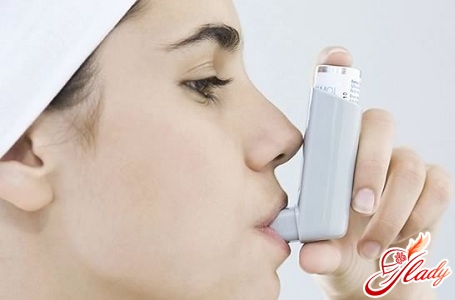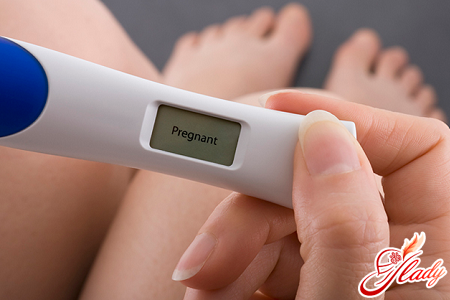 The concept of "asthma" in Greekmeans "shortness of breath", "heavy breathing". To date, this chronic inflammatory disease of the respiratory tract is the most common among the adult population, but the first symptoms of asthma appear in many even in early childhood.
The concept of "asthma" in Greekmeans "shortness of breath", "heavy breathing". To date, this chronic inflammatory disease of the respiratory tract is the most common among the adult population, but the first symptoms of asthma appear in many even in early childhood.
Asthma comes from childhood: the first signs of the disease
Asthma in children occurs due to many factors. It can be heredity, frequent colds, a tendency to allergies, lack of weight, tobacco smoke, which is inhaled by a small child, and so on. The greatest percentage of asthma is seen in boys, children from low-income families and children with black skin. Asthma in children has the following symptoms:
- Frequent attacks of coughing. They can appear during play or sleep, when the child laughs.
- Decreased activity during the game, fast fatigue, weakness.
- Difficulty breathing a child, complaints of chest pain.
- Characteristic whistling and wheezing when exhaling and inhaling.
- Interruptions in breathing, its interception.
- Shortness of breath, difficulty breathing, in which the chest moves back and forth.
- Pinched muscles of chest and neck.
These symptoms can vary in differentattacks and look different. If a child has breathing problems, it should be immediately shown to the doctor. The specialist should carefully examine the child and study his medical history for the presence in her of factors contributing to the propensity of the baby to develop asthma. These can be allergies in his medical history (or parents), frequent colds, lung lesions, skin eczema. Parents should describe in detail the doctor showing symptoms of the child, he, in turn, should carefully examine the baby, having listened to the work of the lungs and the heart. If a child is suspected of developing a disease, a blood test is taken from the child and sent to an X-ray examination of the chest. In some cases, make a skin test for allergies. If asthma is confirmed, on the basis of the severity of the disease the child is prescribed treatment. It consists of the use of bronchodilators and special medications, which should always be at hand at the parents' disposal. The doctor must develop a treatment plan. The disease can be considered controlled if the child is active and lives a full life. He does not show signs of rapid fatigue and does not have pronounced symptoms of the disease. It is understood that parents will very rarely turn to the doctor and the emergency service for acute asthma attacks. In addition, the child should not have side effects from the medications he takes. If you do not sound the alarm in time about the coughing of the baby, fatigue, shortness of breath and other symptoms, do not treat the child and start the disease, then the asthma will develop into a chronic form and accompany the adult person all his life. 
Causes of the disease
Experts note that asthma can beis caused by both environmental and genetic factors affecting the severity of the disease and the success of treatment. However, this complex relationship has not been fully studied to the end. Thanks to research conducted by scientists regarding the spread of asthma and other related diseases (eczema, allergies), information has appeared on some of the risk factors. So, the most significant of them is the presence of atopic disease, which increases the risk of asthma by three to four times, and allergic rhinitis - in five. The increase in immunoglobulin E, as well as a positive allergic test in children thirteen to fourteen years old, as well as in adults, are also risk factors. Due to the fact that asthma is largely associated with increased sensitivity to allergens of the environment, they are paid close attention in childhood - this allows you to diagnose the disease as early as possible. Researches of primary prevention conducted by scientists, which were aimed at actively reducing the content of external stimuli, that is, aeroallergens, showed different data in the room where the child lives. So, for example, the complete disposal of such allergens as home dust mites reduces the risk of allergic sensitization and development of asthma until the baby reaches the age of eight. But at the same time it was found that the effect of allergens in cats and dogs has a completely opposite effect - their presence in the life of a one-year-old child in the future significantly reduces the occurrence of allergic reactions and asthma. The contradictory nature of the findings led scientists to explore other aspects of human life. One of them was the relationship between obesity and the development of asthmatic reactions. In the United States and the United Kingdom, an increase in the incidence of asthma has been a reflection of the growing number of people experiencing problems with excess weight. In Taiwan, where the body mass index of each resident of the country has recently increased by approximately 20%, there has also been an increase in the incidence of allergic symptoms, as well as hyperreactivity of the airways. Some obesity-related factors can also affect the pathogenesis of asthma. Thus, the function of external respiration decreases due to the accumulation of adipose tissue, which in turn leads to the appearance of pro-inflammatory conditions, which is why non-oesophilic asthma develops. Some scientists associate this disease with Cherdzh-Strauss syndrome. In addition, acquired asthma can be a consequence of periocular xanthogranuloma. People with immune-mediated urticaria also experience symptoms such as rash, rhino-conjunctivitis, gastrointestinal problems, asthmatic manifestations, with the worst outcome, anaphylaxis occurs.
Symptoms of bronchial asthma in adults
Symptoms of asthma can appear in early childhood andin case of untimely or incorrect treatment, they develop into a chronic form. However, today very often the first signs of the disease are diagnosed in young people over 20 years of age. In this case, asthma is considered adult. Most often it occurs in the female population and is usually associated with allergies. Almost half of adults suffering from bronchial asthma are also allergic to various external stimuli and substances. The cause of this disease can be the usual working conditions (in this case, asthma is considered professional) or the atmosphere in the apartment (the presence of smokers, animals). Symptoms of the disease worsen when a person falls into certain conditions. So, bronchial asthma is a violation of the lungs, which can arise from such causes:
- inflammation or swelling of the airways;
- when too much mucus is formed, which exceeds the norm;
- with narrowing of the airways due to contraction or contraction of the muscular tissues surrounding them.
The main symptoms of the disease in adults include:
- severe shortness of breath;
- feeling that you do not have enough air;
- a very frequent cough, which is especially "gaining strength" at night;
- During breathing, a person can make a characteristic sound, similar to a whistle.
Unlike adults, children have symptomsbronchial asthma can then appear, then disappear, while in young men and women over 20 they are present regularly and last for a fairly long time. Therefore, in such cases, the daily use of special medications becomes a necessity and allows monitoring the course of the disease. The volume of a light adult man, that is, the amount of air inhaled and exhaled by him in one second, gradually decreases with age. This is directly related to the changes occurring in the muscle tissues, as well as the lack of flexibility of the chest. Due to the decrease in the above indicators, it is quite difficult to determine the onset of the disease in an adult. The risk group, predisposed to the occurrence of bronchial asthma, includes:
- women in the body of which at the moment there are hormonal changes - it can be, for example, pregnancy or menopause;
- Ladies taking estrogen for more than ten years;
- people who have recently suffered a viral illness (flu, sore throat, cold and others);
- predisposed to obesity;
- men and women with allergies (experts especially refer to those who have allergic reactions to the fur of cats);
- people who, due to domestic orthe professional activities of the conditions are constantly in the midst of such irritants as tobacco smoke, fluff, dust, the smell of paint or a strong fragrance of perfume and toilet water.

Diagnosis of bronchial asthma
Of course, none of us is immune from this or that disease, but scientists identify the main categories of people who are more likely to develop asthma than others:
- those with a genetic predisposition;
- there are different forms of allergy;
- people living together with smokers or in the service of duty forced to constantly stay in a smoke-filled room;
- those who live in an industrial zone.
Today, even in our developed world,There is an exact histological, immunological or physiological test for the detection of bronchial asthma. Often, the doctor makes a diagnosis based on the presence of model symptoms (hypersensitivity, difficulty breathing, etc.) or reaction to therapy after a certain period of time (complete or partial recovery). So, let's take a closer look at what characteristics the specialist pays attention to before making a diagnosis:
- First of all, the history of the disease is studied, breathing is listened, the main symptoms are identified (frequent coughing, shortness of breath, chest tightness, wheezing, etc.).
- The lung capacity test is performed. For this, a special device called a spirometer is used. It measures the amount and speed of exhaled air after a deep inhalation. After this examination, the doctor can recommend a bronchodilator or bronchodilator - drugs that help clear the lungs of excess mucus, as well as expanding the airways by relaxing the muscle tissue that compresses them.
- Sometimes, if a survey usingThe spirometer did not give accurate results, another test is being conducted. It consists in the following: the patient inhales by means of an aerosol a special substance (metacholine), which in a patient with asthma causes narrowing of the respiratory tract and spasm. If after the passage of this procedure, lung function decreases by more than 20%, then the test results are considered positive, that is, the presence of bronchial asthma is confirmed. To neutralize the effect of methacholine, it is necessary to use a bronchodilator.
- You can detect asthma with the help of X-raythorax. After examining the lungs, the specialist will determine with greater accuracy, to which disease your symptoms are related. Despite the fact that today this method of diagnosis has become widespread, there are still cases when the asthmatic patient had normal x-ray results.
It should be borne in mind that such symptoms ascough, shortness of breath, increased fatigue, common among people of retirement age, can be mistakenly attributed to COPD (chronic obstructive pulmonary disease), heart failure, or to the aging process. Therefore, before bronchial asthma is diagnosed, it is always recommended to use bronchoconstrictors that cause constriction of the airways.
Classification of asthma
Depending on the frequency of manifestation of certain symptoms, the results of spirometry, as well as other objective indicators, bronchial asthma is divided into four categories:
The category of bronchial asthma is determined by a physician,after which the patient is assigned the appropriate treatment regimen. However, it should be borne in mind that each individual disease of a particular category can manifest itself in different ways. 
Methods of treatment of bronchial asthma
To date, one of the mostAn effective method of treating this disease in adults does not exist. But to live a full life, to prevent the development of chronic symptoms, to be in a normal state and to stop the constant calls of emergency care, a set of measures to reduce the manifestation of asthma, as well as to prevent its further development, is applied. In this process, the main role is played by the patient's proper admission of medications prescribed to him, as well as avoidance of contact with external irritants causing seizures. Today, two main types of medications are used to prevent and treat asthma: anti-inflammatory drugs and bronchodilators. The former are used in most cases and are aimed at reducing inflammatory processes and reducing the amount of mucus that forms in the airway of a person. In order to achieve good results and reduce the appearance of symptoms, it is necessary to take such drugs daily for a certain time. These drugs reduce the severity of seizures, have a beneficial effect on the passage of oxygen through the respiratory tract, reduce sensitivity and damage, and therefore symptoms are becoming less common. Thus, following the recommendations of the doctor and taking prescribed anti-inflammatory drugs, you can not only monitor the course of the disease, but also prevent its further development. The second type of medications used to combat asthma include bronchodilators, which help relax the airway compressing muscle tissue. These instantaneous agents immediately after their application normalize breathing, giving oxygen the ability to freely enter the human body. In addition, they can clean the respiratory tract of mucus, which due to them is easily expectorated. There are also short-term drugs aimed at alleviating and eliminating the symptoms of the disease, manifested as a sudden attack. Bronchodilators are also used, with which you can not only control the course of bronchial asthma, but also prevent the recurrence of symptoms in the future. They are classified as a long-term instrument. The patient can be treated in two ways: by inhaling medications (nebulizer, dosed silt powder inhaler) and / or by using oral medications (eg, tablets and liquid syrups). Many of the above drugs are incompatible with each other, so before you take them, you must always consult a doctor. In addition, the most effective treatment to date is also the definition of initiating factors - it can be tobacco smoke or pet hair, possibly aspirin - and limiting contact with them. If the avoidance of stimuli does not help, medication is performed Remember that the signs of asthma can be correctly determined only by a qualified specialist through a series of surveys. Based on the medical history, as well as the severity of the symptoms, a special regimen will be drawn up - a program for the treatment of bronchial asthma. It describes the system by which drugs should be taken and the necessary actions when the patient's condition worsens. After drawing up a treatment plan, make sure that you understand the doctor correctly, because to avoid serious problems and health it is very important to follow the instructions and follow the prescribed regimen. We advise you to read:









